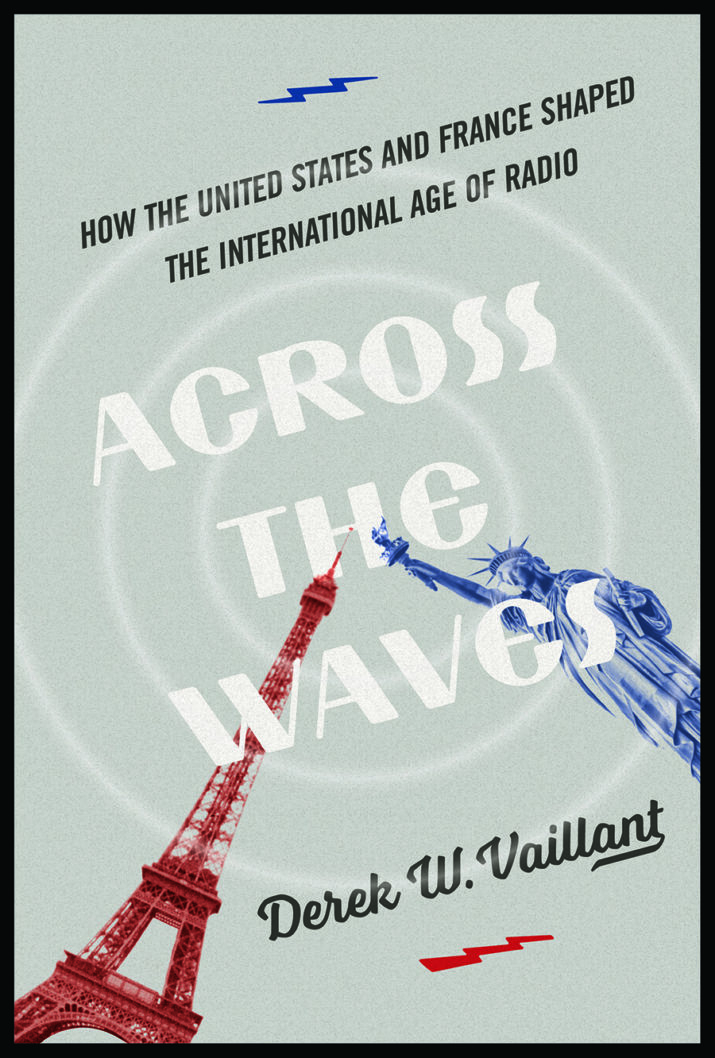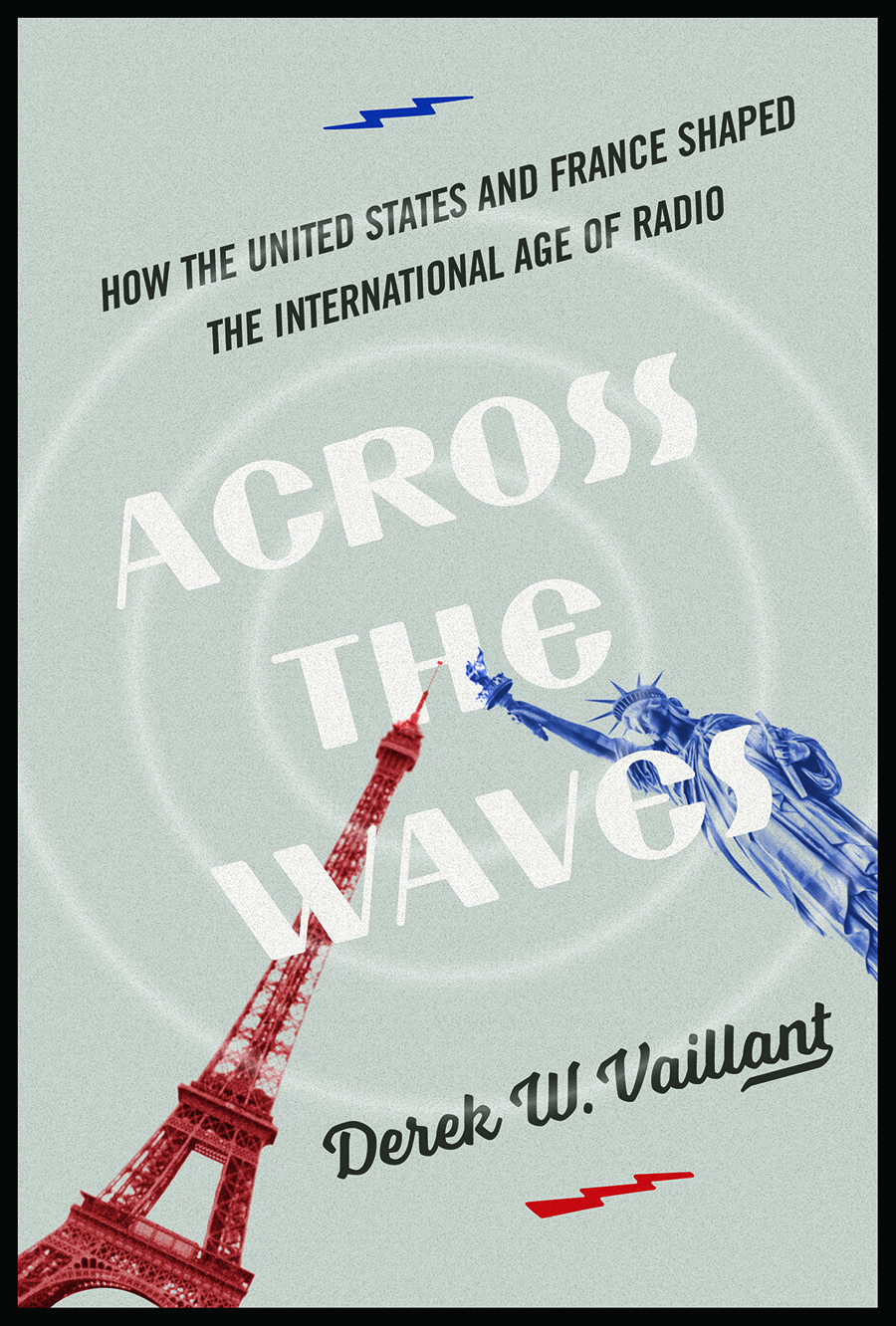
Across the Waves: How the United States and France Shaped the International Age of Radio by Derek W. Vaillant

As a scholar of both radio and the sea, the catchy title of Derek Vaillant’s second book, Across the Waves was, perhaps unsurprisingly, immediately appealing to me. Playing on both the transmission of broadcasts via electromagnetic waves and the movement of ideas, culture, and politics across the ocean waves, back and forth between the United States (US) and France, the title of the book encapsulates the motivation behind this work—to tease apart a complex, intriguing, and largely obscured socio-political history and geography between the two sea-separated nations from the 1920s to the 1990s as writ through the medium of international broadcasting. As expressed in Vaillant’s own words, the book aims to explore the “users and developers of US-French broadcasting to illuminate the complexity of international broadcasting and reveal its consequences for cultural affairs and geopolitics” (3), and does so through careful, detailed research drawing on a variety of textual and sound archives, making for a rich and expressive account. The book is split into two core sections, one focused on the period pre- and during World War II (1925-1944) and the other on the time-frame post-World War II, through a changing socio-cultural landscape in the US and France, and the Cold War era (1945-1974). The afterword takes the narrative of broadcasting relations into the 1990s to reflect on the more recent forces shaping radio and international connections between the two nations.
Readers of this review might be forgiven for thinking, given the description thus far, that this book only has appeal to those interested in media history, radio communications, or the particularities of international relations between the US and France. In some respects, the book might appear quite niche. Indeed, in spite of my own research on radio and maritime affairs—I wondered what the book might offer me as someone who has no explicit interest in US-French relations, or the specificity of this broadcasting connection—both of which are central tenets of this work. On this basis—playful title aside—I have to admit, I wasn’t quite expecting to enjoy this book as much as I did. This book is more than a narrow geographically-bounded discussion of the US and France through a very specialized lens of radio broadcasting history. The topic area, and Vaillant’s handling of it, make this an expansion and encompassing analysis of a wider set of global relations and fractions, techno-political linkages and cultural assemblages. The book is certainly concerned with the US and France, but it also brings in a broader set of players—from Germany, to Britain and beyond—implicated within this broadcasting relationship. It also demonstrates how broadcasting is not a limited field in and of itself, but a lens for making-sense of global connections anew, shining light on unrecognized elements of international collaboration and diplomacy. As such, it is a book that should have much wider appeal than the title suggests, and as a surprised and captivated reader, I’d strongly recommend it as a text with reach beyond its immediately identifiable contribution.
This is not to say the book doesn’t have very specific gains for readers who are interested in radio or international relations between the US and France. Indeed, one of the key take-home messages of the book for media and radio scholars is a need to take seriously the medium of international broadcasting. Work on this topic remains scant. My own work on pirate broadcasting from within international space (the high seas), for example, falls into discussing this phenomenon within the frameworks of particular national broadcasting organizations rather than considering the international linkages created through “illicit” radio operations. This reflects perhaps, a deaf-spot for scholars of radio relations and histories. As Vaillant notes, international broadcasting is often treated as “modular add-on” to existing forms of broadcasting theory and empirical-work, rather than a “dynamic constituent” of broadcasting demanding attention in its own right (4). Vaillant’s book is therefore an important corrective to this, as well as an advert for what an international analysis of sound might achieve. For scholars not just of radio, but of US-French relations, the book is simply packed with examples that help understand the complex association between the two countries anew. Shifting away from conventional studies of political relationships that might be revealed through more conventional sources of archival data (such as official government documents), Vaillant uses broadcasting as a lens and a soundboard, offering a unique insight into relations—and one that is probably previously unheard. In Chapter 3, for example, Vaillant recounts a fascinating, yet at times heart-breaking, history of the ways broadcasting provided information during World War II, built solidarities, yet also created moments of distrust, where listeners did not know which account to believe via the radio set. This chapter also relays the important social history of listeners writing to radio stations—revealing the ways in which radio cannot only be thought of as a one-to-many form of unidirectional communication, but a dialogue that builds bonds with listeners in unexpected and significant ways.
In respect of what is “heard” in this book, a further strength of the text is the way in which particular individuals are identified and employed to tell narratives of international (radio) relations. Vaillant’s technique of personalizing the history through key people works to give voice to those under-recognized figures in forging both radio and socio-cultural political relations—as well as making the account embodied and relatable to the reader. For example, in Chapter 2, Vaillant introduces us to Fred Bates, a central figure responsible for developing the foundations of the US-France broadcasting relationship in the 1920s and early 1930s, describing the “painstaking effort” made by Bates and an “interwar generation of U.S. radio producers and correspondents in France and other places, shaping… the art of the possible in foreign news broadcasting” (32). In Chapter 4, Pierre Crénesse—a popular radio commentator and later director of French Broadcasting in New York—takes a leading role as a figure through which post-World War II US-French radio relations were forged. Here Vaillant draws on Crénesse’s exceptional vision for the distribution of French radio in the US (using the so-called “platter” system) to unpick the wider implications of this for post-War relations in the Marshall Plan era. Chapter 5, perhaps my personal favorite, changes tone, and through the broadcasting of Marjorie Dunton—an Anglo-American Paris fashion designer—and others, examines cultural connections through the Bonjour Mesdames programs charting from the 1940s to 1960s. Here, Vaillant is able to reflect on the post-war exchange of ideas around gender roles, sexuality and wider sexual politics, and the lasting impacts of this for stereotypes of French (and US) women (and men).
All this said there are two areas where the book might have developed debates further. First, for me as a scholar of critical geopolitics, the book promised to use international broadcasting as a window for understanding geopolitical relations. There is no doubt the book does do this, but what geopolitics is understood to be in this book, alongside a clearer sense of how we might understand some of what is described in the text as geopolitical, is underdeveloped. Much discussion of the underscoring geopolitics in each chapter is implicit rather than explicit, and in some cases, the reader may be left wanting slightly more focused analysis. More engagement with literatures in geopolitics and geopolitical relations—from disciplines such as geography, international relations or political theory—may have further couched and contextualized the careful geopolitical discussions embedded within the book. Second, this book—perhaps like all books on radio—suffers from the fate of being a textual account of sound. Reading Chapters 3 and 5, in particular, despite the superbly evocative quotes of recordings, readers can’t (or at least I couldn’t) help but want to hear those recordings myself. The format of academic work, the nature of archive permissions and copyright, alongside the practical offerings of publishers in dissemination, prevent more novel forms of communicating research. Books on radio and sound, such as this, act as vital reminders that we should and must develop such novelty to share research in different formats, to enable new modes of engagement with academic work and a deeper appreciation of the central arguments authors may make. Of course, this project is beyond Vaillant alone, and is perhaps something all scholars of sound should be pushing for. Indeed, as Vaillant concludes, the study of radio, is about “human-level concerns, such as the desire to speak, to tell, to be heard, as well as to listen, to grow and to learn from others” (158). It is important to find ways that such “telling”, “hearing”, ‘listening” and “learning” might be better achieved in “writing” about radio. However, whilst I imagine many readers may likewise be left wishing that they could tune in to some of the broadcasts that feature in the text, the atmospheric way Vaillant brings radio to us in this book should still be nothing short of highly commended.
Kimberley Peters is Professor of Marine Governance at the Helmholtz Institute for Functional Marine Biodiversity, based at the University of Oldenburg in Germany. She is a geographer by trade, interested in the governance of non-grounded spaces: primarily the sea, but also the air, radio waves and most recently, outer space.
Across the Waves: How the United States and France Shaped the International Age of Radio
By Derek W. Vaillant
Publisher: University of Illinois Press
Paperback / 258 pages / 2017
ISBN: 978-0-252-08293-1
Published on March 30, 2020.




